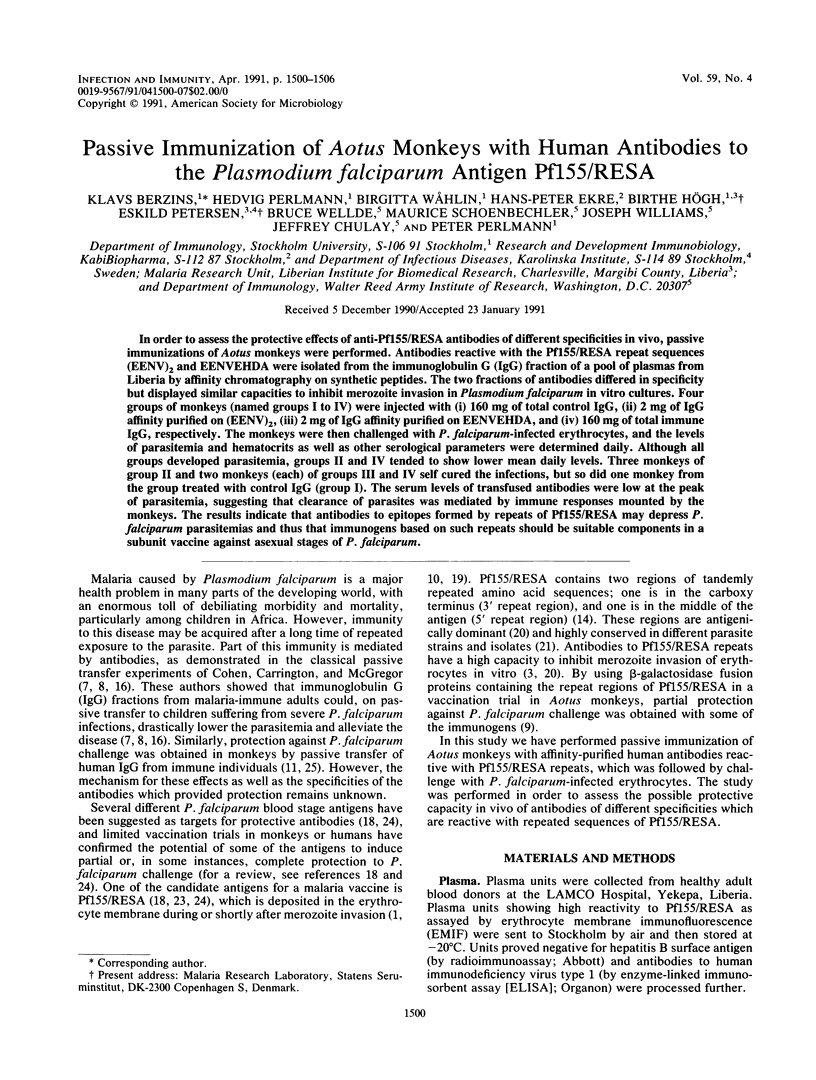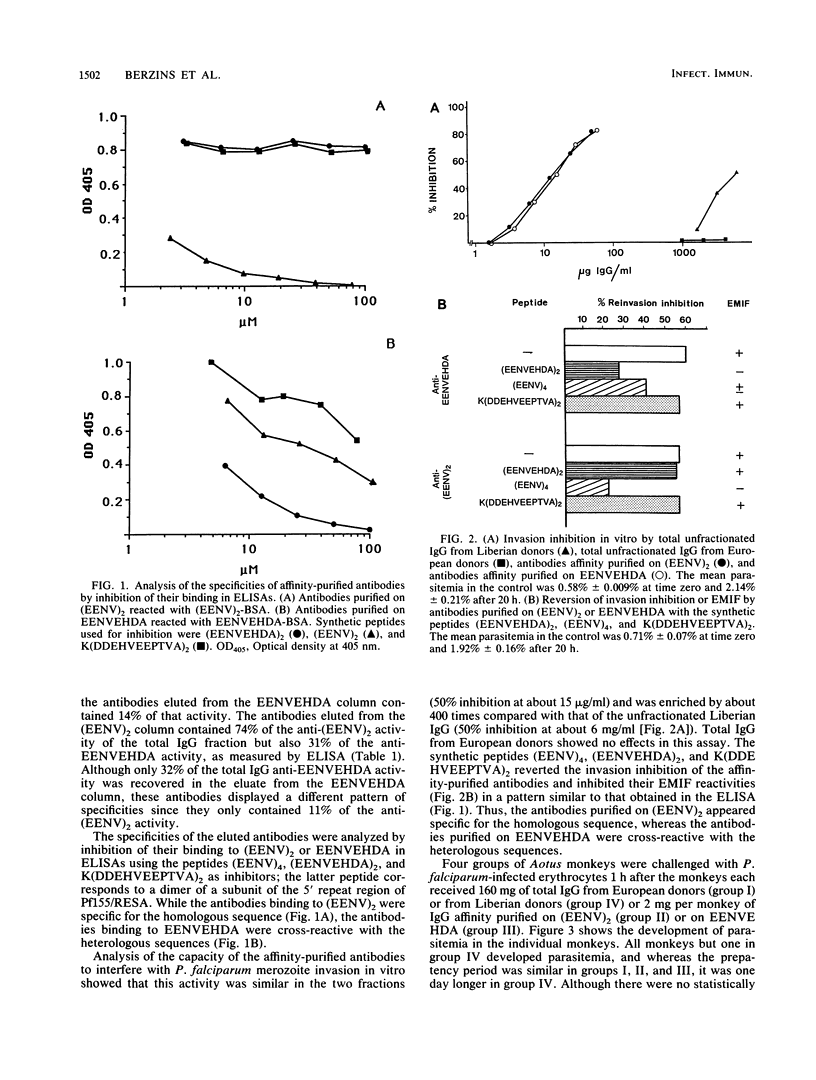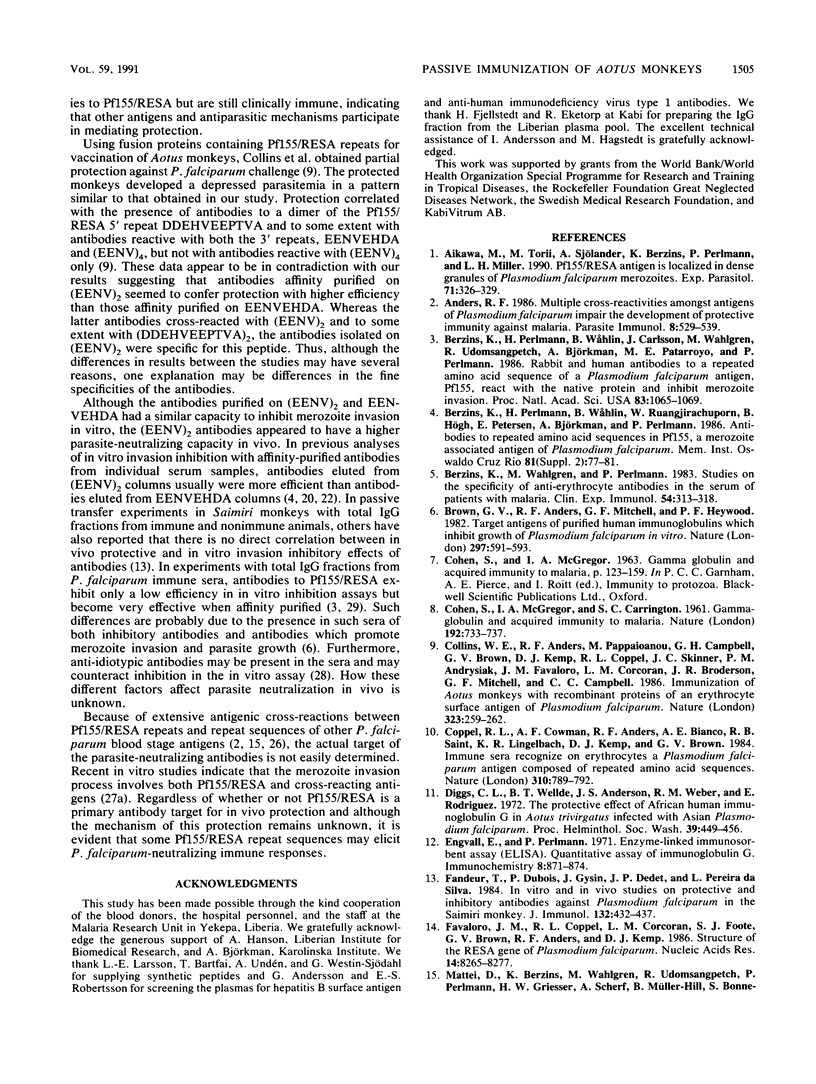Abstract
In order to assess the protective effects of anti-Pf155/RESA antibodies of different specificities in vivo, passive immunizations of Aotus monkeys were performed. Antibodies reactive with the Pf155/RESA repeat sequences (EENV)2 and EENVEHDA were isolated from the immunoglobulin G (IgG) fraction of a pool of plasmas from Liberia by affinity chromatography on synthetic peptides. The two fractions of antibodies differed in specificity but displayed similar capacities to inhibit merozoite invasion in Plasmodium falciparum in vitro cultures. Four groups of monkeys (named groups I to IV) were injected with (i) 160 mg of total control IgG, (ii) 2 mg of IgG affinity purified on (EENV)2, (iii) 2 mg of IgG affinity purified on EENVEHDA, and (iv) 160 mg of total immune IgG, respectively. The monkeys were then challenged with P. falciparum-infected erythrocytes, and the levels of parasitemia and hematocrits as well as other serological parameters were determined daily. Although all groups developed parasitemia, groups II and IV tended to show lower mean daily levels. Three monkeys of group II and two monkeys (each) of groups III and IV self cured the infections, but so did one monkey from the group treated with control IgG (group I). The serum levels of transfused antibodies were low at the peak of parasitemia, suggesting that clearance of parasites was mediated by immune responses mounted by the monkeys. The results indicate that antibodies to epitopes formed by repeats of Pf155/RESA may depress P. falciparum parasitemias and thus that immunogens based on such repeats should be suitable components in a subunit vaccine against asexual stages of P. falciparum.
Full text
PDF






Selected References
These references are in PubMed. This may not be the complete list of references from this article.
- Aikawa M., Torii M., Sjölander A., Berzins K., Perlmann P., Miller L. H. Pf155/RESA antigen is localized in dense granules of Plasmodium falciparum merozoites. Exp Parasitol. 1990 Oct;71(3):326–329. doi: 10.1016/0014-4894(90)90037-d. [DOI] [PubMed] [Google Scholar]
- Anders R. F. Multiple cross-reactivities amongst antigens of Plasmodium falciparum impair the development of protective immunity against malaria. Parasite Immunol. 1986 Nov;8(6):529–539. doi: 10.1111/j.1365-3024.1986.tb00867.x. [DOI] [PubMed] [Google Scholar]
- Berzins K., Perlmann H., Wåhlin B., Carlsson J., Wahlgren M., Udomsangpetch R., Björkman A., Patarroyo M. E., Perlmann P. Rabbit and human antibodies to a repeated amino acid sequence of a Plasmodium falciparum antigen, Pf 155, react with the native protein and inhibit merozoite invasion. Proc Natl Acad Sci U S A. 1986 Feb;83(4):1065–1069. doi: 10.1073/pnas.83.4.1065. [DOI] [PMC free article] [PubMed] [Google Scholar]
- Berzins K., Wahlgren M., Perlmann P. Studies on the specificity of anti-erythrocyte antibodies in the serum of patients with malaria. Clin Exp Immunol. 1983 Nov;54(2):313–318. [PMC free article] [PubMed] [Google Scholar]
- Brown G. V., Anders R. F., Mitchell G. F., Heywood P. F. Target antigens of purified human immunoglobulins which inhibit growth of Plasmodium falciparum in vitro. Nature. 1982 Jun 17;297(5867):591–593. doi: 10.1038/297591a0. [DOI] [PubMed] [Google Scholar]
- COHEN S., McGREGOR I. A., CARRINGTON S. Gamma-globulin and acquired immunity to human malaria. Nature. 1961 Nov 25;192:733–737. doi: 10.1038/192733a0. [DOI] [PubMed] [Google Scholar]
- Collins W. E., Anders R. F., Pappaioanou M., Campbell G. H., Brown G. V., Kemp D. J., Coppel R. L., Skinner J. C., Andrysiak P. M., Favaloro J. M. Immunization of Aotus monkeys with recombinant proteins of an erythrocyte surface antigen of Plasmodium falciparum. Nature. 1986 Sep 18;323(6085):259–262. doi: 10.1038/323259a0. [DOI] [PubMed] [Google Scholar]
- Coppel R. L., Cowman A. F., Anders R. F., Bianco A. E., Saint R. B., Lingelbach K. R., Kemp D. J., Brown G. V. Immune sera recognize on erythrocytes Plasmodium falciparum antigen composed of repeated amino acid sequences. 1984 Aug 30-Sep 5Nature. 310(5980):789–792. doi: 10.1038/310789a0. [DOI] [PubMed] [Google Scholar]
- Engvall E., Perlmann P. Enzyme-linked immunosorbent assay (ELISA). Quantitative assay of immunoglobulin G. Immunochemistry. 1971 Sep;8(9):871–874. doi: 10.1016/0019-2791(71)90454-x. [DOI] [PubMed] [Google Scholar]
- Fandeur T., Dubois P., Gysin J., Dedet J. P., da Silva L. P. In vitro and in vivo studies on protective and inhibitory antibodies against Plasmodium falciparum in the Saimiri monkey. J Immunol. 1984 Jan;132(1):432–437. [PubMed] [Google Scholar]
- Favaloro J. M., Coppel R. L., Corcoran L. M., Foote S. J., Brown G. V., Anders R. F., Kemp D. J. Structure of the RESA gene of Plasmodium falciparum. Nucleic Acids Res. 1986 Nov 11;14(21):8265–8277. doi: 10.1093/nar/14.21.8265. [DOI] [PMC free article] [PubMed] [Google Scholar]
- Merrifield R. B. Solid-phase peptide synthesis. Adv Enzymol Relat Areas Mol Biol. 1969;32:221–296. doi: 10.1002/9780470122778.ch6. [DOI] [PubMed] [Google Scholar]
- Miller L. H., Howard R. J., Carter R., Good M. F., Nussenzweig V., Nussenzweig R. S. Research toward malaria vaccines. Science. 1986 Dec 12;234(4782):1349–1356. doi: 10.1126/science.2431481. [DOI] [PubMed] [Google Scholar]
- Perlmann H. K., Berzins K., Wåhlin B., Udomsangpetch R., Ruangjirachuporn W., Wahlgren M., Perlmann P. H. Absence of antigenic diversity in Pf155, a major parasite antigen in membranes of erythrocytes infected with Plasmodium falciparum. J Clin Microbiol. 1987 Dec;25(12):2347–2354. doi: 10.1128/jcm.25.12.2347-2354.1987. [DOI] [PMC free article] [PubMed] [Google Scholar]
- Perlmann H., Berzins K., Wahlgren M., Carlsson J., Björkman A., Patarroyo M. E., Perlmann P. Antibodies in malarial sera to parasite antigens in the membrane of erythrocytes infected with early asexual stages of Plasmodium falciparum. J Exp Med. 1984 Jun 1;159(6):1686–1704. doi: 10.1084/jem.159.6.1686. [DOI] [PMC free article] [PubMed] [Google Scholar]
- Perlmann H., Perlmann P., Berzins K., Wåhlin B., Troye-Blomberg M., Hagstedt M., Andersson I., Högh B., Petersen E., Björkman A. Dissection of the human antibody response to the malaria antigen Pf155/RESA into epitope specific components. Immunol Rev. 1989 Dec;112:115–132. doi: 10.1111/j.1600-065x.1989.tb00555.x. [DOI] [PubMed] [Google Scholar]
- Perlmann P., Berzins K., Perlmann H., Troye-Blomberg M., Wahlgren M., Wåhlin B. Malaria vaccines: immunogen selection and epitope mapping. Vaccine. 1988 Apr;6(2):183–187. doi: 10.1016/s0264-410x(88)80025-2. [DOI] [PubMed] [Google Scholar]
- Perrin L. H., Simitsek P., Srivastava I. Development of malaria vaccines. Trop Geogr Med. 1988 Jul;40(3):S6–21. [PubMed] [Google Scholar]
- Sadun E. H., Hickman R. L., Wellde B. T., Moon A. P., Udeozo I. O. Active and passive immunization of chimpanzees infected with West African and Southeast Asian strains of Plasmodium falciparum. Mil Med. 1966 Sep;131(9 Suppl):1250–1262. [PubMed] [Google Scholar]
- Udomsangpetch R., Carlsson J., Wåhlin B., Holmquist G., Ozaki L. S., Scherf A., Mattei D., Mercereau-Puijalon O., Uni S., Aikawa M. Reactivity of the human monoclonal antibody 33G2 with repeated sequences of three distinct Plasmodium falciparum antigens. J Immunol. 1989 May 15;142(10):3620–3626. [PubMed] [Google Scholar]
- Wahlgren M., Berzins K., Perlmann P., Björkman A. Characterization of the humoral immune response in Plasmodium falciparum malaria. I. Estimation of antibodies to P. falciparum or human erythrocytes by means of microELISA. Clin Exp Immunol. 1983 Oct;54(1):127–134. [PMC free article] [PubMed] [Google Scholar]
- Wåhlin B., Berzins K., Perlmann H., Anders R. F., Perlmann P. Anti-idiotypic antibodies counteract the invasion inhibition capacity of antibodies to major epitopes of the Plasmodium falciparum antigen Pf155/RESA. Infect Immun. 1990 Sep;58(9):2815–2820. doi: 10.1128/iai.58.9.2815-2820.1990. [DOI] [PMC free article] [PubMed] [Google Scholar]
- Wåhlin B., Wahlgren M., Perlmann H., Berzins K., Björkman A., Patarroyo M. E., Perlmann P. Human antibodies to a Mr 155,000 Plasmodium falciparum antigen efficiently inhibit merozoite invasion. Proc Natl Acad Sci U S A. 1984 Dec;81(24):7912–7916. doi: 10.1073/pnas.81.24.7912. [DOI] [PMC free article] [PubMed] [Google Scholar]


